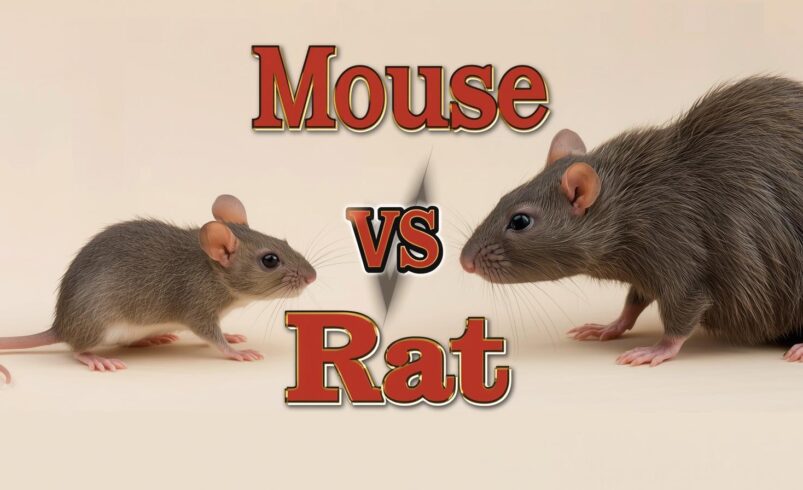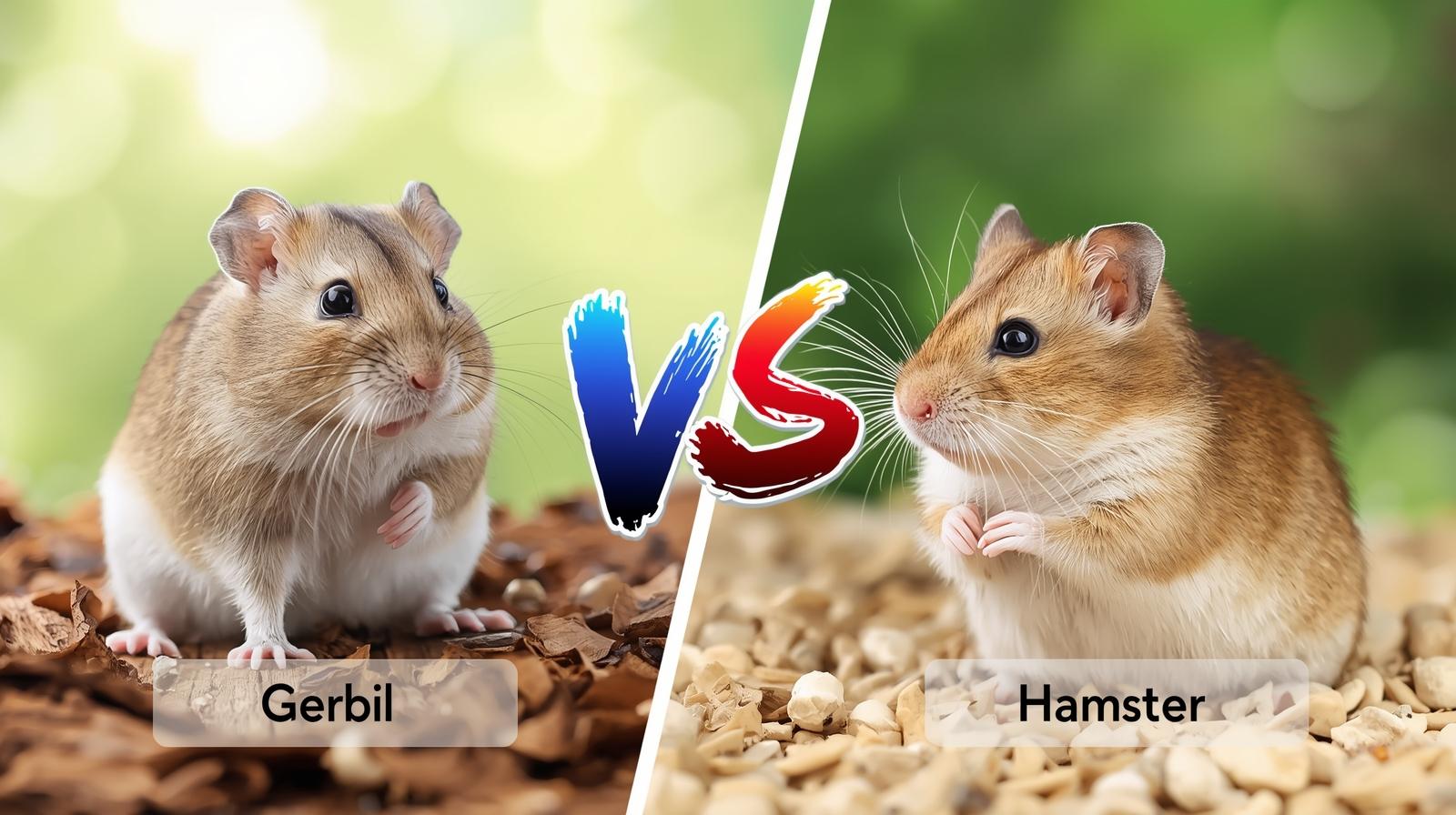When I first moved into my apartment three years ago, I heard scratching sounds in the walls at night. Was it a mouse or rat? That question kept me awake for weeks. The difference matters more than you might think, and understanding the distinction between mouse vs rat can save you time, money, and countless sleepless nights.
According to recent data, rodents infest approximately 21 million U.S. homes annually, making proper identification crucial for effective pest control. Whether you’re dealing with these unwelcome houseguests or simply want to educate yourself about common rodents, this comprehensive guide will help you distinguish between rats and mice while exploring their behaviors, habitats, and impact on our lives.
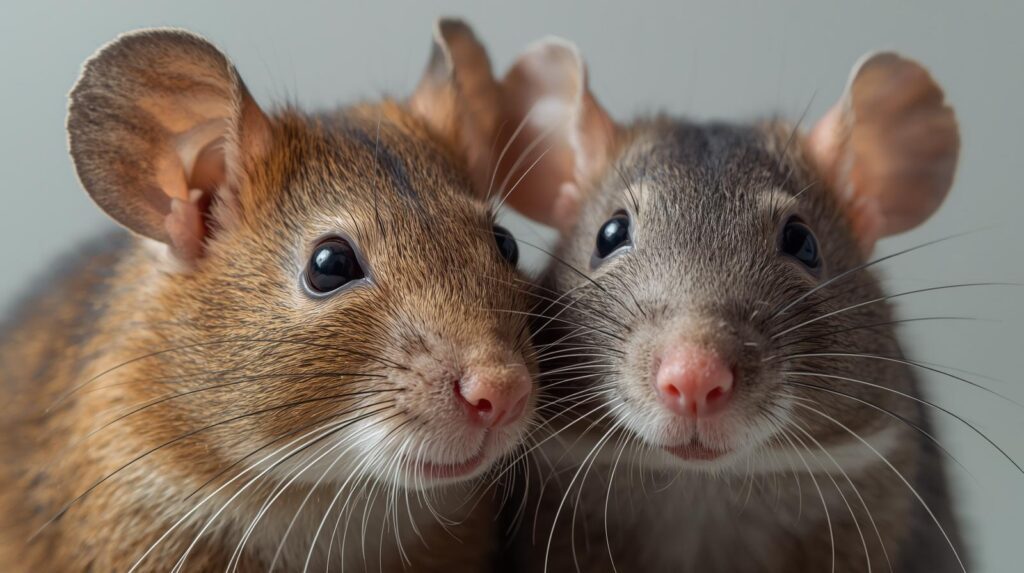
Table of Contents
Understanding the Basic Differences: Mouse vs Rat
The mouse vs rat debate starts with recognizing their physical characteristics. While both belong to the rodent family, their differences are striking once you know what to look for.
Size stands as the most obvious distinguishing factor. A typical house mouse measures between two to four inches in body length, whereas the Norway rat spans seven to nine inches. However, this comparison becomes tricky when you encounter a young rat, which might appear mouse-sized at first glance.
Beyond size, several physical features help differentiate these rodents. Mice possess proportionally larger ears relative to their head size, and their tails are typically longer than their bodies. Rats, conversely, have smaller ears in proportion to their heads, and their tails are usually shorter or equal to their body length. The snout shape also differs significantly mice have triangular, pointed snouts while rats display blunter, more robust facial features.
Adult rats weigh eight to ten times more than adult mice, a substantial difference that affects everything from their movement patterns to the damage they can cause in your home.
Physical Characteristics That Set Them Apart
When examining mouse vs rat distinctions, physical traits provide reliable identification markers. The body structure of rats is noticeably thicker and more muscular compared to the slender, delicate build of mice.
Limb development differs considerably between these species. Rats possess stronger, more developed limbs that enable them to navigate diverse terrains with impressive agility. This physical advantage allows rats to climb, swim, and burrow more effectively than mice. Mice, with their smaller and more delicate limbs, excel at squeezing through impossibly small spaces a gap as narrow as a dime can accommodate a determined mouse.
The coat texture and coloring also vary. House mice typically display light brown or gray fur with lighter-colored bellies. Norway rats, the most common rat species in urban areas, have coarse brown or gray fur with scattered black hairs throughout their coat.
One often-overlooked detail: rat droppings are significantly larger than mouse droppings. Rat droppings measure about three-quarters of an inch long and are blunt at the ends, while mouse droppings are much smaller at one-eighth to one-quarter inch and have pointed ends.
Behavioral Patterns: How Mouse and Rat Differ
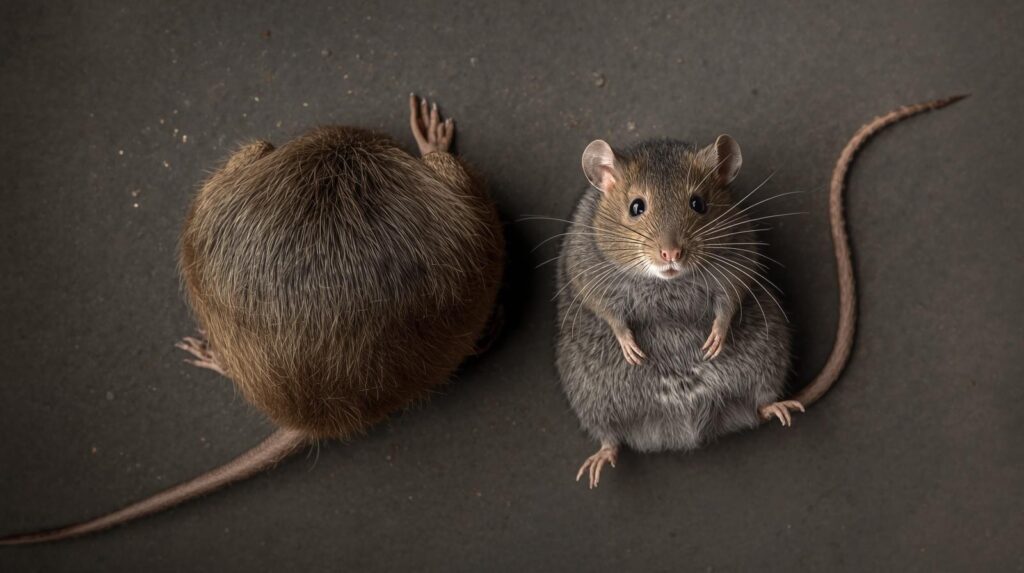
Understanding behavior is essential when comparing mouse vs rat species. These behavioral differences affect how infestations develop and how to address them effectively.
Mice are naturally curious and exploratory creatures. They tend to investigate new objects in their environment, making bait traps more effective. Rats, however, display neophobia a fear of new things. They’ll often avoid new objects or food sources for several days, which complicates pest control efforts.
Territorial habits differ markedly. A single mouse doesn’t typically require much space, with their territory often spanning just 10-30 feet from their nest. Rats establish larger territories, sometimes ranging up to 100-150 feet from their nesting sites.
The mouse vs rat feeding behavior comparison reveals interesting contrasts. Mice are nibblers, taking small bites from multiple food sources throughout the night. Rats, being larger, consume more food at once and tend to return to the same feeding location repeatedly. This behavioral difference influences trap placement and baiting strategies.
Social structures also vary. Both species are social animals, but mice tend to live in smaller family groups, while rats often form larger, more complex colonies with established hierarchies.
Habitat Preferences and Nesting Behaviors
The mouse vs rat habitat comparison shows distinct preferences that can help you predict where infestations might occur.
Mice prefer to nest in secluded areas close to food sources. They commonly build nests inside wall voids, attics, basements, and even inside stored furniture or appliances. Their nests consist of shredded paper, fabric, and other soft materials formed into a ball roughly the size of a grapefruit.
Rats typically nest outdoors when possible, choosing burrows in soil, beneath concrete slabs, or in thick vegetation. When they do move indoors, they prefer lower levels of buildings basements, crawl spaces, and ground floors. The Norway rat, in particular, excels at creating extensive burrow systems with multiple entrances.
According to recent statistics, Vermont leads U.S. states with 24.1% of households experiencing rodent issues, followed by South Dakota at 23.2% and North Dakota at 22.9%. These harsh winter climates drive rodents indoors, highlighting how environmental factors influence mouse vs rat habitat selection.
Both species seek shelter offering three essentials: food, water, and warmth. However, their specific requirements differ. Mice can survive on very little water, often obtaining sufficient moisture from their food. Rats require a reliable water source and will typically nest within 100 feet of water.
Health Risks: Mouse vs Rat Disease Transmission
When evaluating mouse vs rat health implications, both species pose significant risks to human health, though in somewhat different ways.
Rodents can carry numerous diseases that spread directly or indirectly to humans. Disease transmission occurs through multiple pathways: rodent droppings, urine, saliva, bites, and the parasites they carry such as ticks, mites, and fleas.
Mice commonly transmit hantavirus, a potentially fatal respiratory disease contracted by breathing air contaminated with rodent waste. They also spread salmonellosis through contaminated food and surfaces. Lymphocytic choriomeningitis (LCMV), another serious illness, is primarily associated with house mice.
Rats historically gained notoriety for spreading plague through infected fleas. While modern plague outbreaks are rare in developed countries, rats continue to spread leptospirosis through urine-contaminated water, rat-bite fever through bites or scratches, and typhus through infected fleas.
The mouse vs rat disease comparison shows that approximately 21 million U.S. homes face rodent infestations annually, putting millions at risk of exposure to these pathogens. Both baby boomers and younger generations now recognize rodents as significant public health threats.
For proper Pet care and household safety, understanding these health risks is paramount. Professional pest control becomes essential when infestations are detected, as DIY methods often prove inadequate for established rodent populations.
Comparing Reproduction Rates and Population Growth
The mouse vs rat reproductive comparison reveals why even small rodent problems can rapidly escalate into major infestations.
Mice reach sexual maturity remarkably quickly as early as five to six weeks of age. A single female mouse can produce five to ten litters annually, with each litter containing five to six young. This means one breeding pair of mice can theoretically produce dozens of offspring in a single year.
Rats mature slightly slower, reaching breeding age around eight to twelve weeks. Female rats produce fewer litters than mice typically three to six per year but each litter is larger, containing seven to twelve pups. Despite fewer litters, the larger litter size means rats can still create substantial population growth.
The lifespan difference between these species affects their population dynamics. Mice typically live 12-18 months in the wild, while rats can survive 18-24 months. These relatively short lifespans combined with rapid reproduction rates explain why rodent populations explode so quickly when conditions are favorable.
Understanding these reproductive patterns is crucial for effective pest management. Addressing mouse vs rat infestations early prevents the exponential population growth that makes later control efforts exponentially more difficult and expensive.
Mouse vs Rat in Scientific Research
Beyond pest control concerns, the mouse vs rat comparison extends into the scientific realm, where both species have made invaluable contributions to medical research.
Approximately 111.5 million rats and mice were used annually in American laboratories during 2017-18, according to scientific estimates. Their anatomical, physiological, and genetic similarities to humans make them preferred subjects for biomedical research.
The humanized mouse and rat model market is projected to reach $409.8 million by 2030, reflecting the growing importance of these animal models in drug development and disease research. North America dominated this market in 2024, accounting for approximately 40% of global revenue due to robust biotechnology and pharmaceutical industries.
When comparing mouse vs rat research applications, each species offers distinct advantages. Adult rats weigh eight to ten times more than adult mice, making them advantageous for imaging and surgical procedures, particularly those involving the spinal cord and brain. Their larger size also facilitates blood collection and drug administration.
Mice, however, offer benefits in genetic research due to the extensive availability of transgenic mouse models and established genomic tools. The mouse genome was fully sequenced earlier than the rat genome, giving researchers a head start in developing genetic modifications.
Mouse models are particularly pivotal in immunology and inflammation studies, facilitating detailed analyses of immunological processes through targeted genetic alterations. This specialization explains why the immunology and infectious diseases segment held the second-largest market share in the humanized rodent model industry in 2024.
Identification Tips for Homeowners
Practical mouse vs rat identification skills empower homeowners to respond appropriately when suspecting a rodent problem.
Start by examining any droppings you discover. Mouse droppings are small (1/8 to 1/4 inch), dark, and pointed at the ends. Rat droppings are significantly larger (3/4 inch), blunt-ended, and resemble capsules. The quantity and location of droppings indicate the severity and type of infestation.
Listen to nighttime sounds. Mice produce light, rapid scurrying sounds and high-pitched squeaking. Rats create heavier, slower movements and occasionally emit loud squeals or grinding sounds when they gnaw.
Examine gnaw marks on food packaging, wood, or wiring. Mouse gnaw marks are small and clean with tiny scratches. Rat gnaw marks are larger, more aggressive, and often accompanied by visible wood chips or plastic fragments.
Track patterns provide additional clues. Mice create small, dusty trails along walls where their fur brushes repeatedly. Rats establish more visible runways, often outdoors along foundations or fences, marked by greasy smudges from their coarser fur.
When comparing mouse vs rat identification, consider the time factor. If you’re seeing adult rodents, size becomes obvious. A four-inch rodent is definitely a mouse, while anything approaching or exceeding seven inches is certainly a rat.
Prevention Strategies: Keeping Both Rodents Away
Effective prevention doesn’t require differentiating between mouse vs rat species many strategies work for both.
Seal all exterior openings larger than a quarter-inch. Mice can squeeze through dime-sized gaps, while rats need spaces about half-inch wide. Use steel wool, caulk, or metal flashing to close these entry points around pipes, vents, doors, and foundation cracks.
Eliminate food sources by storing pantry items in airtight metal or thick plastic containers. Clean up spills immediately, don’t leave pet food out overnight, and secure garbage in rodent-proof bins with tight-fitting lids. Both mice and rats are attracted to easily accessible food, making proper food storage essential.
Reduce outdoor attractions by trimming vegetation away from your home’s foundation, removing debris piles, and storing firewood at least 20 feet from buildings. These modifications make your property less appealing to both mouse and rat populations seeking shelter.
Address moisture issues promptly. Fix leaky pipes, improve drainage around your foundation, and ensure proper ventilation in basements and crawl spaces. While mice can survive with minimal water, removing water sources still makes your home less hospitable.
For comprehensive rodent prevention and alldandy solutions, consider professional pest inspections annually, especially before winter when rodents seek indoor warmth.
Professional vs DIY Rodent Control
The mouse vs rat control approach differs slightly, but both often benefit from professional intervention.
DIY methods like snap traps and glue boards work for minor mouse problems, especially when you’ve caught one or two individuals quickly. However, mice reproduce so rapidly that visible signs of one mouse often indicate many more hidden in your walls.
Rat control typically requires professional expertise from the start. Rats’ neophobic behavior makes them trap-shy, and their larger size means they can potentially injure themselves in poorly placed traps, creating inhumane situations. Professionals understand rat behavior patterns and can place bait and traps strategically for maximum effectiveness.
According to pest control industry data, more than 165,000 rodent service requests occurred nationwide in 2024, demonstrating the scale of the rodent problem and the demand for professional solutions. Cities consistently experience high rodent activity year over year, indicating that professional intervention often becomes necessary.
When dealing with mouse vs rat infestations, professionals offer additional advantages: identifying entry points you might miss, using commercial-grade products unavailable to consumers, and providing monitoring to ensure complete eradication. They also understand local regulations regarding rodenticide use and can implement integrated pest management approaches that minimize environmental impact.
The cost of professional services varies by infestation severity but typically proves more economical than repeated DIY attempts that fail to eliminate the entire rodent population.
Regional Differences in Mouse and Rat Populations
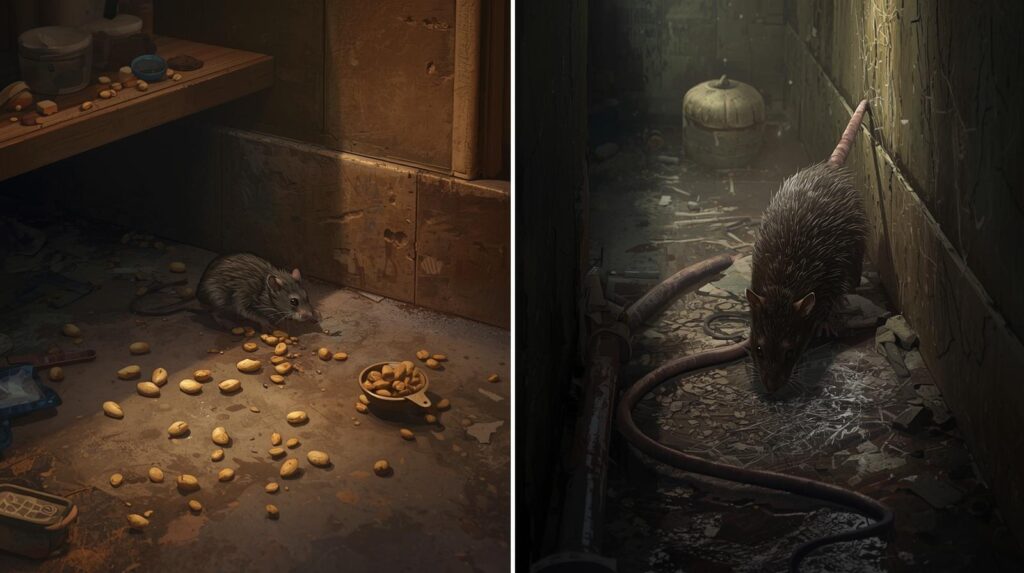
Geographic location significantly influences mouse vs rat population dynamics and species prevalence.
Cold climate states experience higher rodent pressure during winter months. Vermont, South Dakota, and North Dakota lead the nation with over 22% of households reporting rodent issues. These harsh winters drive rodents indoors more aggressively than in temperate regions.
Urban vs. rural environments also affect mouse vs rat populations differently. Cities often face more severe rat problems due to abundant food waste, extensive sewer systems providing harborage, and dense human populations. Mice, being smaller and more adaptable to various environments, thrive in both urban and rural settings.
Coastal regions sometimes experience different species compositions. The roof rat (Rattus rattus), also called the black rat, predominates in warmer coastal areas, particularly in Southern states. These rats are excellent climbers and often nest in attics and upper stories, unlike Norway rats that prefer ground-level locations.
According to recent reports analyzing mouse vs rat distribution patterns, rodent infestations surge during fall as temperatures drop and food sources become scarce outdoors. This seasonal pattern remains consistent nationwide, though timing varies by climate zone.
Understanding your region’s typical rodent species helps you implement appropriate prevention and control measures. What works for Norway rats in Chicago might need adjustment for roof rats in Miami or deer mice in rural areas.
The Economic Impact of Rodent Infestations
The mouse vs rat economic burden extends far beyond pest control service costs.
Property damage constitutes a major expense. Rodents gnaw constantly to keep their continuously growing teeth worn down, damaging electrical wiring (potentially causing fires), destroying insulation, chewing through pipes, and ruining stored belongings. Insurance claims related to rodent damage reach into billions annually, though many homeowners policies exclude rodent damage, leaving property owners to absorb these costs.
Food contamination and loss represent another significant impact. Restaurants, food processing facilities, and grocery stores face particularly severe consequences from mouse vs rat infestations, including health code violations, forced closures, legal liability, and reputation damage. Even residential food loss adds up when rodents contaminate pantries.
The agricultural sector suffers substantially from rodent damage to crops and stored grain. Rodents consume and contaminate massive quantities of food products globally, contributing to food security challenges and economic losses for farmers and agricultural businesses.
Healthcare costs associated with rodent-borne diseases, though difficult to quantify precisely, add another economic dimension. Treating illnesses like hantavirus, leptospirosis, and salmonellosis requires medical intervention, and severe cases may necessitate hospitalization.
The pest control industry’s economic role reflects these concerns. The industry employs thousands of professionals and generates billions in annual revenue, underscoring society’s need to address mouse vs rat problems systematically.
Comparison Table: Mouse vs Rat at a Glance
| Characteristic | Mouse | Rat |
|---|---|---|
| Body Length | 2–4 inches | 7–9 inches |
| Weight | 0.5–1 oz | 8–10 oz |
| Tail Length | Longer than body | Equal to or shorter than body |
| Ears | Large, relative to head | Small, relative to head |
| Snout Shape | Triangular, pointed | Blunt, robust |
| Droppings | 1/8–1/4 inch, pointed ends | 3/4 inch, blunt ends |
| Lifespan | 12–18 months | 18–24 months |
| Litters per Year | 5–10 | 3–6 |
| Pups per Litter | 5–6 | 7–12 |
| Behavior | Curious, exploratory | Neophobic (fear of new things) |
| Territory Range | 10–30 feet | 100–150 feet |
| Preferred Nesting | Inside walls, attics | Burrows, basements |
This comprehensive comparison highlights the key differences that matter most when identifying and addressing rodent problems in your home or business.
Conclusion: Making Informed Decisions About Rodent Control
Understanding the mouse vs rat distinction empowers you to respond effectively when facing a rodent problem. From the physical differences in size and appearance to behavioral contrasts in curiosity and territorial ranges, these two rodent types require slightly different control approaches despite many similarities.
The health risks both species pose shouldn’t be underestimated. With approximately 21 million U.S. homes experiencing rodent infestations annually, and rodent populations capable of rapid exponential growth due to their impressive reproductive rates, early detection and swift action become essential for protecting your home and family.
Whether you’re dealing with the curious, nibbling habits of mice or the cautious, neophobic behavior of rats, professional pest control often provides the most reliable solution, especially for established infestations. Meanwhile, consistent prevention sealing entry points, eliminating food sources, and maintaining clean, clutter-free spaces offers your best defense against future invasions.
My own experience taught me that the scratching sounds in my walls were actually mice, not rats. Armed with proper identification knowledge and professional help, I resolved the issue within weeks. Now I maintain vigilant prevention habits because I know how quickly a single mouse can become dozens.
The mouse vs rat debate isn’t just academic it’s practical knowledge that helps you protect your home, health, and peace of mind. What steps will you take today to prevent rodents from making your house their home?
Frequently Asked Questions (FAQs)
Q1: Can baby rats be mistaken for adult mice?
Yes, young rats can appear similar in size to adult mice, which often causes confusion. However, you can distinguish them by examining ear size relative to the head (mice have proportionally larger ears), tail length relative to body (mice have longer tails), and foot size (young rats have noticeably larger feet than adult mice). A baby rat will also have a blunter snout compared to a mouse’s triangular face.
Q2: Which is more dangerous in homes mice or rats?
Both pose significant health risks, though in different ways. Rats cause more structural damage due to their size and stronger gnawing ability, including chewing through concrete and metal pipes. Mice, however, reproduce faster and can infiltrate more areas of your home through smaller openings. From a disease perspective, both carry serious pathogens, so neither should be considered “safe.” The primary danger depends on the specific species, infestation severity, and your home’s vulnerability.
Q3: Why do rodent problems increase during fall and winter?
As temperatures drop and outdoor food sources become scarce, rodents actively seek warm shelter with readily available food making your home an attractive destination. Fall coincides with harvest season when rodents naturally seek grain stores, an instinct that now drives them toward human structures. This seasonal pattern occurs nationwide, with recent data showing consistent rodent activity surges each fall based on over 165,000 service requests analyzed in 2024.
Q4: How quickly can a small rodent problem become a major infestation?
Extremely quickly due to rapid reproduction rates. A single pair of mice can theoretically produce dozens of offspring within months, with females reaching sexual maturity at just five to six weeks old and producing five to ten litters annually. Rats reproduce slightly slower but still create significant population growth, with females producing three to six litters of seven to twelve pups each year. This exponential growth explains why addressing rodent problems immediately proves so critical.
Q5: Are natural predators effective for controlling mouse and rat populations?
While natural predators like cats, owls, and snakes can help reduce rodent populations, they rarely eliminate infestations completely, especially in urban environments or inside structures. Outdoor cats may catch some mice and rats, but studies show they often prefer easier prey. Barn owls effectively control rural rodent populations when provided with nesting boxes, but this approach works best as prevention rather than remediation. For active infestations, professional pest control combined with exclusion methods provides more reliable results than relying solely on natural predation. Have you considered which prevention methods would work best for your specific situation?

